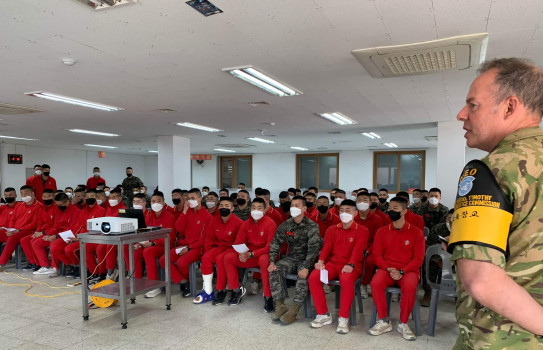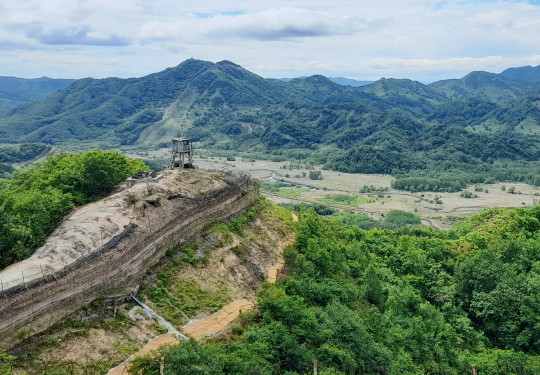Armistice Education Officer on Korea’s demilitarised zone
Personnel who operate in and around the Korean Demilitarised Zone need to be aware of the provisions and obligations of the Korean Armistice Agreement, signed in 1953. Enter the Armistice Education Officer, a role filled by NZDF personnel.
12 January, 2023

The Korean Demilitarised Zone (DMZ) is a 245 x 4 km area of land straddling the Korean Peninsula from the Han River Estuary in the West to the Gangwon-Do province and the city of Sokcho in the East. It is a monument of razor wire, guard posts and minefields. But because it is also generally devoid of human disturbance it has become a nature reserve. Rare plants, animals and birds flourish in the DMZ. Commonly seen are vampire deer, known as such because of their elongated teeth. Reported, but rarely seen, are Asian Black Bears, or Moon Bears. And legendary, but never seen in the DMZ, is the Siberian or Korean Tiger. The tiger used to roam the corridors between Korea and the Peoples’ Republic of China but the loss of habitat has resulted in an inevitable decline. The tiger features significantly in Korean culture and folklore, with the painting ‘Jakhodo’ (magpie, tiger, and painting) often displayed during the start of the lunar calendar to ward off evil spirits.
Guarding the DMZ, on the southern side of the wire, are units from the Republic of Korea (ROK) Armed Forces. The Han River Estuary and the North West Islands, a strategically important island group close to the coast of the Democratic Peoples’ Republic of Korea (DPRK) are the security responsibility of the ROK Marine Corps. On the peninsula itself, the responsibility falls to various divisions of the ROK Army, many of which have glorious histories dating back to the Korean War and the Vietnam War, where several Korean units distinguished themselves with feats of bravery and fortitude.
The ROK Armed Forces also consists of a modern and well equipped Air Force that recently fired missiles into the waters of the DPRK to reciprocate yet another missile firing from the North where missiles landed close to Ulleungdo Island and less than 60km from the city of Sokcho.
Guarding the waters of both coastlines is the ROK Navy, another well-equipped and determined body of men and women who regard defending their country as a patriotic duty.
All of the personnel, who operate in and around the DMZ, need to be aware of the provisions and obligations of the Korean Armistice Agreement signed on 27 July 1953. Be they conscript or regular, officer or other rank, they need to understand and apply the Armistice obligations to de-escalate a situation where possible and to avoid hostilities. By doing so they continue to support the stability and prosperity of the ROK.
Enter the Armistice Education Officer (AEO), a role filled by members of the NZDF under the remit of op MONITOR. A member of the United Nations Command Military Armistice Commission – Secretariat (UNCMAC-S), the AEO is responsible for briefing the ROK units be they Navy, Marine, Army or Air Force, about the Armistice Agreement, and convincing the more sceptical that the Armistice Agreement is to be followed despite the training they might have received at unit level, and the rhetoric of the administration of the day regarding provocations from the DPRK.
To achieve this effectively the AEO must be an educator. But they must also be able to command the stage. The ROK Armed Forces, due to Confucian traditions, is very rank conscious. Young conscripts will not speak to a senior officer, particularly a Gaijin or foreigner, especially if there is a possibility of embarrassment. So to be an effective AEO you need to throw off the shackles of rank and engage however and whenever you can. During my tenure as AEO we introduced a pop quiz to get the audience participating as soon as possible, and I was a brand Ambassador for Whittaker’s Chocolate (other chocolate is available) rewarding engagement and good questions or discussion with some of the finest chocolate NZ has to offer.
As the AEO I travelled all along the DMZ to deliver training to ROK units and some US units in Panmunjom. Briefings were delivered to the Air Force Academy and the Army Third Academy with its enormous stage and screen; a real rock star moment. I travelled by Blackhawk to brief the Marines in the North West Islands, an area bristling with heavy weapons and multi-launch rocket systems.
A typical week would see the Education team head out on the road for a journey lasting anywhere between two and five hours. As most journeys required getting around the mega city that is Seoul, a stop at the services was always required. I can recommend these service stations because the mix of Korean and Western food is exceptional. You have to try the black-bean noodles.
On arrival at the host unit we would typically conduct a site survey of a facility to check its accessibility and availability to members of the public. Despite it being almost 70 years since the Armistice Agreement was signed, the DPRK still holds a sense of wonderment for many Koreans and international visitors. To look out and observe this Hermit Kingdom, even from afar, is a big hit and the Government of the Republic of Korea continues to develop observatories and peace trails that include access to the DMZ.
The key part of the road trip is, of course, the briefings to the troops. The Education team delivered two 2hr briefs each day. The introduction included a snap shot of NZ’s involvement in the Korean War and our country’s commitment to the Armistice Agreement. The United Nations Command is explained before a summary of the obligations and responsibilities of those operating in the DMZ is provided. The most important section of the briefing is the discussion about Rules of Engagement and the application of the concept of hostile intent. The conscripts are trained on unit Standard Operating Procedures (SOP), ie if X happens do Y then Z. The UNCMAC-S approach to hostile intent encourages a more analytical approach; to assess a number of factors before deciding if the enemy is demonstrating hostile intent, and so force can be used in response.
To assist understanding a number of scenarios are used as a training aid. These help the troops make the necessary connections and encourage discussion. There is no wrong answer. There are just some answers that are more helpful then others. On occasions the audience will include Senior NCOs or officers who were actually involved in the incident that is being taught. Their insights are invaluable and they appreciate that the scenarios are to aid training and not to be critical of any aspect of the ROK Armed Forces.
Training and engaging with members of the ROK Armed Forces is the purpose of the AEO role. It is also the highlight. Koreans are an incredibly warm and welcoming people who genuinely appreciate the efforts of all New Zealanders who serve in their country. The bonus of the AEO is the opportunity to travel through some exceptional countryside. The most breath-taking is the Haean Basin or the Punchbowl in Gangwon province. But anywhere along the DMZ provides spots to stop and look at this amazing country.
